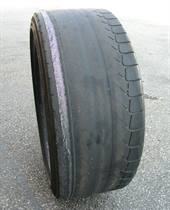 Many years ago my wife and young son (we only had one at the time) and I were on a two day car trip. Early on in the trip it became apparent that the car was pulling to the right. At first it was only a small nuisance, only noticeable if we let go of the steering wheel slightly, but as the miles passed the pull became stronger and stronger. Eventually it was a chore to fight against the strong pull. We had to cut our speed and change drivers more frequently due to the fatigue caused by constantly pulling with our arms and shoulders (I’m finding I have to consciously let my shoulders down even now as I write this years later). When we made a gas stop I thought to check the tires. I was absolutely floored to see the tires that had been in good shape when we left, were almost worn through to the tread on the inside of the front tires.
Many years ago my wife and young son (we only had one at the time) and I were on a two day car trip. Early on in the trip it became apparent that the car was pulling to the right. At first it was only a small nuisance, only noticeable if we let go of the steering wheel slightly, but as the miles passed the pull became stronger and stronger. Eventually it was a chore to fight against the strong pull. We had to cut our speed and change drivers more frequently due to the fatigue caused by constantly pulling with our arms and shoulders (I’m finding I have to consciously let my shoulders down even now as I write this years later). When we made a gas stop I thought to check the tires. I was absolutely floored to see the tires that had been in good shape when we left, were almost worn through to the tread on the inside of the front tires.
When we arrived at our destination we arranged for the alignment to be fixed and bought new tires, replacing the worn front pair. After our visit, we drove home in comfort. But that’s not the end of the story. After a few months we began to hear a sound coming from the rear differential. It turned out that the tires we bought were a slightly different size than the existing back tires. This small difference in circumference caused the wheels to turn at different speeds and that small difference put strain on the power train. In the end we needed to replace the rear differential joint as well.
There are so many parallels in this story to how we lead our lives and the lesson of alignment is huge if we are to reach our goals and feel like we have traction along the way.
In order to be most effective in our lives we must align our actions with our vision for our future. If we have good goals and a great reason why we are striving for those goals, but our actions on a day to day basis don’t align with those intentions, all we end up doing is passing time. Just as improper alignment in my car led to friction and breakdown. Actions that are not consistent with our goals make us climb hills that are unnecessary in our life. If you have ever uttered the phrase “how did I get here?”, you know what I mean.
For example, if it is your goal to lose weight and you continually eat fast food and take extra  helpings of dessert it’s obvious that your actions are not in alignment with your goal.
helpings of dessert it’s obvious that your actions are not in alignment with your goal.
But not all examples are so easy. Many people wonder why they are not getting anywhere in their life. The calendar turns and they are in the same position as they were a year ago. In my opinion there are two main causes for this atrophy. The first is a lack of direction and the second is a lack of alignment between goals and daily actions.
Most people live their life as it comes and hope that it gets better. Most of us have good intentions and do many things right, but without stopping to chart a course and focusing on that plan we are just driving around and may or may not reach our destination.
Just as it was in the car example, when our daily actions are not in alignment with our goals we create friction that keeps us from reaching our destination. When we are out of alignment it is much easier to get off track. Even a small pull in the wrong direction over time will leave you wondering what went wrong.
In summary:
- In order to reach our full potential we must have a long term vision and shorter term goals that define what we want to see.
- In order to reach our goals our actions must be consistent with those goals.
- If our goals are not in alignment with our intentions it causes friction. If we do ultimately reach our goals it will be much harder and there may be many broken and worn out parts when we finally get there.
- If we are not in alignment we might miss our destination altogether and find that we are just driving around really well.
- The most successful people in every field have a strong purpose, have aligned their actions with their purpose and stay focused on their vision by continually checking that they are on the right track.
Action step: In the next week set aside a block of quiet, uninterrupted time and do some what I call 30,000 foot thinking. That is when you take a long view of your life and then step it all the way back to what you need to do today to help you get to where you want to be in the future. After you have chartered your course keep checking and make sure your trajectory is on track. This is called life planning and in the end it saves a lot of gas.
